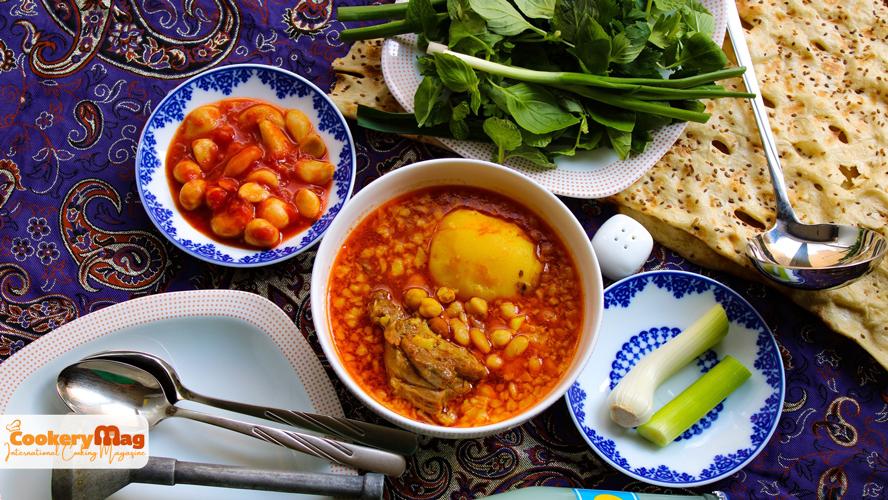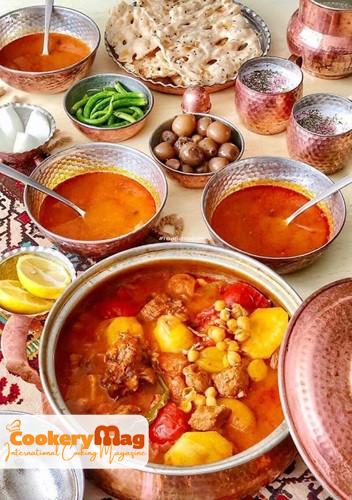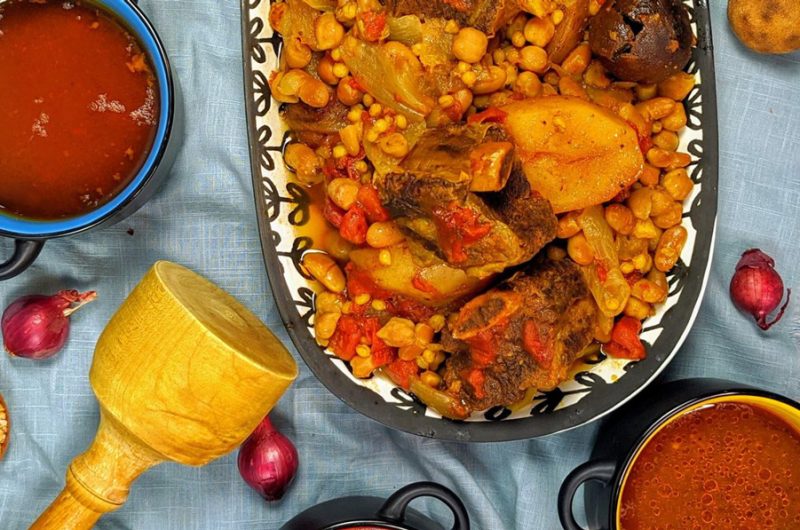© All Rights Reserved.
Abgoosht Recipe | Persian Lamb and Chickpea Stew
If we want to think about the most traditional Iranian food or know the authentic taste of Iran according to tourists’ taste, the first option that comes to mind is Abgoosht.
The food that has been imprinted in our memories since childhood in family gatherings with its traditional customs is still considered one of the popular dishes to touch those memories again in family weekend gatherings.
This traditional food is so intertwined with our lives that we may never think about when its history goes back and whether it has changed during this past time or not.
In this article in Cookery Magazine, we will try to provide comprehensive and useful information about this traditional and authentic Iranian food.
Ingredients for making Abgoosht
| Lamb shank | 500 grams |
| White beans (Navy bean) | ½ a cup |
| Chickpeas | ½ a cup |
| Tomato | 2 medium sizes |
| potatoes | 2 medium sizes |
| Onions | 2 medium sizes |
| Tomato paste | 2 tablespoons |
| Salt and black pepper | As much as needed |
| Turmeric | As much as needed |
To make the broth (Abgoosht) taste slightly sour, dried lime is added to it in some places.
Of course, you should be careful that the dried lime does not make the Abgoosht taste bitter. We can use two methods to prevent the Abgoosht from becoming bitter.
The first method uses powdered dried lime; the second is to put it in boiling water for a few minutes before adding dried lime to remove its bitterness.
For better broth quality, it is recommended to use homemade dried lime.
Recipe for making Abgoosht
The first step
To prepare traditional Abgoosht, it is better to soak chickpeas and white beans in two bowls of water separately the night before, and if possible, change the water in the bowls several times so that the swelling of the beans is completely removed and they are easier to cook.
The second step
Pour some oil into a pot and add the meat to start cooking. Fry the meat well until it changes color, then rinse the peas and beans, add them to the pot, and fry them for about a minute.
The third step
At this stage, we add the tomato skin and one of the onions to the pot, then add eight glasses of boiling water. One of the important points about making the abgoosht tastier is to add boiling water.
The fourth step
We reduce the heat under the pot and let the abgoosht cook with a very gentle heat. After you add the boiling water, let your abgoosht ingredients stay on low heat for 2-3/30 hours until the abgoosht thickens.

The fifth step
After 2 hours and 30 minutes, we wash the potatoes and add them to the pot. After adding the potatoes, remove the fat in the pot and beat it well with the remaining onion until they are completely crushed, then add it to the pot again.
The sixth step
After the meat is fully cooked, fry the tomato paste well in a small pan until it is fried, then add it to the pot along with some salt and black pepper. Roasting tomato paste makes our abgoosht more colorful.
The seventh step
After adding the tomato paste, we let the abgoosht stay on low heat for another 30 minutes until it fully settled, then we took it off the heat and set it aside.
The eighth step
You can serve the broth in two ways:
The first and traditional method is to serve the abgoosht separately, beat the rest of the ingredients well with a meat grinder, and serve the pounded meat separately. The second method is adding beans and meat to each person’s bowl.
What should we serve along with abgoosht?
Since ancient times, Iranians have been using a variety of pickles, vegetables, onions, and chives to serve broth (Abgoosht). In such a way, this is an undeniable food habit that is passed from generation to generation to our new families.
We unknowingly benefit from their healing properties by consuming these foods together.
People who go for various types of pickles to serve broth increase iron absorption in red meat and abgoosht by the body.
Besides, consuming pickles with broth, which is considered a relatively heavy food, can help in better digestion of this food and reduce the amount of fat absorption in the body to its minimum.
How to make Abgoosht (Dizi) in a pressure cooker
To prepare Persian Lamb and Chickpea Stew in a pressure cooker, first put the meat in the pressure cooker along with peas and beans.
Then we divide the onions into 4 parts and put them in the pressure cooker along with the water. Add the spices, close the pressure cooker’s lid, and put it on the heat.
It takes about 45 minutes to an hour to cook the ingredients. After the meat, peas, and beans are well cooked, transfer the abgoosht to the pot and add the tomatoes and potatoes. We also fry the tomato paste. Then we add to the pot.
Next, we pour the abgoosht tail fat together with the onions into a bowl and beat it well with a meat grinder until they are completely crushed, then pour it into the broth pot. After the potatoes are cooked, we serve our abgoosht.
Having a journey in the history of Abgoosht
The exact presence of Abgoosht among Iranians is not exactly known, but the oldest document found that mentions this dish dates back to the 8th century AH!
Of course, in the old texts, this dish is not mentioned by the name “Abgoosht,” and it is mostly called “Shorbaj.”
Also, much earlier than this, this food was common
among the people as Nokhodab (pea water) or Yakhni. Therefore, cooking food with broth content goes back years ago.
Of course, the name of Yakhni is still heard among some cities like Kazerun and Shiraz, which is a food like Abgousht.

But in general, abgoosht is a food that is common in almost all of Iran, and it is currently the food of the middle class of the society.
In the past, this dish was also known as party food and served as a tonic dish at parties.
Dizi or Abgousht is one of the authentic Iranian dishes. Many people believe that the history of abgoosht (dizi) goes back to the time of settlement and animal husbandry, and it is the food of nomads, and only when they reach their final destination do they find the opportunity and conditions to cook abgoosht.
That is when people started making pottery and stoneware dishes. Today, this main and delicious food has a lesser status among Iranians. But abgoosht is considered a complete food and is rich in nutrients.
Persian Lamb and Chickpea Stew, a ritual food
From the earliest times until now, Abgoosht has been a guest on the tables in the ceremonies of the Iranian people, including mourning, especially the religious mourning of Imam Hossein (PBUH) and weddings.
These rituals included the birth ceremony and the circumcision ceremony. Even broth was used for reception at funerals in the past.
One of the interesting traditions that has been prevalent among many Iranian tribes was that with the help of relatives and local people, a sheep was donated to the family of the deceased person, and with the cooperation of everyone, the funeral abgoosht (broth) is going to cook, and in this way, all Participants were fed at the closing ceremony.

In the past, during the holy month of Ramadan, especially for Suhur, Tehranis used to cook a special broth to which they added nuts and ingredients such as almonds, pistachios, hazelnuts, and even apricot leaves. This energetic broth prepared people for fasting.
Is the nature of Abgoosht hot or cold?
Abgoosht has a hot nature, and eating it more in the cold seasons of the year is recommended. Abgoosht consists of potatoes, beans, onions, or vegetables. They are all rich sources of protein, calcium, and iron.
Abgoosht is a food with a lot of calories and should be taken into consideration from several aspects because any food with a lot of calories leads us to gain weight and to be overweight and this kind of food has its own effects.
But it is wrong to think that abgoosht causes ulcers in the stomach or duodenum. The broth is excellent for weak and infirm people, sick people, and especially for children and teenagers in growing age.
Benefits of Abgoosht
Of course, Abgousht, one of our ancestors’ most routine dishes and whose history goes back a long time ago, initially did not contain potatoes and tomatoes.
These two things were not yet known to Iranians at the time of Dizi’s creation. Whatever we say about the benefits of Abgoosht, is so less than its real benefits.
This food can be one of the perfect foods for children’s growth, although the parents’ lack of attention to their children’s food has caused them to distance themselves from authentic and profitable Iranian foods and gravitate towards fast foods.
• Red and fatty meat is a rich source of iron with high absorption.
• Peas and beans are a source of vegetable protein. The body’s fiber and protein are supplied through legumes.
• Carbohydrates in potatoes as a sweet and starchy grain is the reason for their high-calorie content. Also, beta-carotene, the precursor of vitamin A, is very suitable for weak children.
• Onion is an enemy of cholesterol; for this reason, it is recommended to be consumed with abgoosht.
• If using the foreshank, the body absorbs calcium, phosphorus, and vitamin D.
• Turmeric is one of the best blood purifiers.
Conclusion
Thank you for being with us with this delicious and popular traditional food. If you have any questions, it’s my honor to answer. Enjoy your exploration of Persian cuisine!
Please share this article with your friends on Facebook, Twitter, Pinterest, and other social media. 🧡
Abgoosht Recipe | Persian Lamb and Chickpea Stew
Course: Main CourseCuisine: Persian FoodDifficulty: Hard4
servings10
minutes4
minutes300
kcalAbgoosht or Dizi is one of the traditional Iranian foods including meat, sheep’s tail, onion, potato, tomato (or tomato paste), peas, and beans.
Ingredients
Lamb shank, 500 grams
White beans (Navy bean), ½ a cup
Chickpeas, ½ a cup
Tomato, 2 medium sizes
potatoes, 2 medium sizes
Onions, 2 medium sizes
Tomato paste, 2tbsp
Salt and black pepper, As much as needed
Turmeric, As much as needed
Directions
- The first step
To prepare traditional Abgoosht, it is better to soak chickpeas and white beans in two bowls of water separately the night before, and if possible, change the water in the bowls several times so that the swelling of the beans is completely removed and they are easier to cook. - The second step
Pour some oil into a pot and add the meat to start cooking. Fry the meat well until it changes color, then rinse the peas and beans, add them to the pot, and fry them for about a minute. - The third step
At this stage, we add the tomato skin and one of the onions to the pot, then add eight glasses of boiling water. One of the important points about making the abgoosht tastier is to add boiling water. - The fourth step
We reduce the heat under the pot and let the abgoosht cook with a very gentle heat. After you add the boiling water, let your abgoosht ingredients stay on low heat for 2-3/30 hours until the abgoosht thickens. - The fifth step
After 2 hours and 30 minutes, we wash the potatoes and add them to the pot. After adding the potatoes, remove the fat in the pot and beat it well with the remaining onion until they are completely crushed, then add it to the pot again. - The sixth step
After the meat is fully cooked, fry the tomato paste well in a small pan until it is fried, then add it to the pot along with some salt and black pepper. Roasting tomato paste makes our abgoosht more colorful. - The seventh step
After adding the tomato paste, we let the abgoosht stay on low heat for another 30 minutes until it fully settled, then we took it off the heat and set it aside. - The eighth step
You can serve the broth in two ways:
The first and traditional method is to serve the abgoosht separately, beat the rest of the ingredients well with a meat grinder, and serve the pounded meat separately. The second method is adding beans and meat to each person’s bowl.


